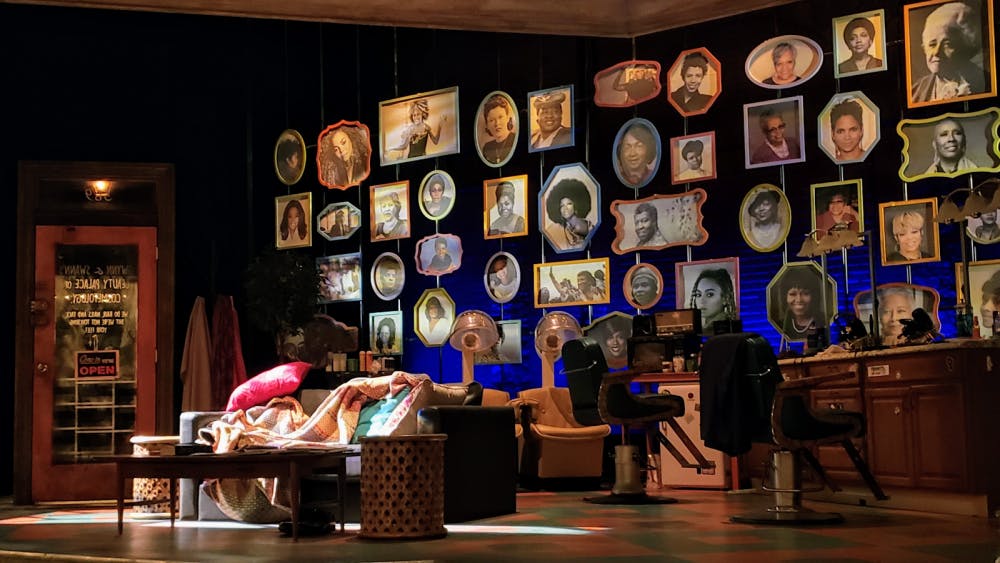Marcus Gardley’s A Wonder in My Soul, which is showing at Baltimore Center Stage from Nov. 29 to Dec. 23, is the story of the strength of two black women and their unbreakable friendship. The friendship has survived six decades of hardships and is now faced with the trial of surviving Baltimore’s gentrification.
Set in 2008, the play follows the lives of Swann Park Sinclair (played by Harriett D. Foy) and Gwynn Oak Falls (played by Wandachristine), two childhood friends who have been running Gwynn and Swann’s Beauty Palace of Cosmetology in Baltimore for the last 40 years.
After being the most influential beauty salon in the city for 30 years and styling some of the most powerful African-American women of the last few decades, the salon has unfortunately fallen onto hard times as the neighborhood around them has become run down by neglect and crime.
Their problems are amplified when Gwynn’s son Andrew (Stanley Andrew Jackson III), who runs a nonprofit organization that helps to keep the neighborhood children off the streets by through sports and healthier forms of recreation, loses their loan of more than $100,000 and now faces embezzlement charges.
The inevitable gentrification of the neighborhood comes much to the excitement of the church pastor’s wife Cedonia Mosher (played by Alexis J. Roston), self-ordained as the First Lady and a regular at the salon who now lives in a luxurious house in the county. It threatens the existence of the historic community safe space, as the women are unable to pay the mortgage on a building whose value has exponentially increased overnight.
Through the relationships between the characters and the struggle of keeping the business afloat, the audience experiences a multi-faceted view of African-American life and history.
It gives us vignettes of Swann and Gwynn in their youth (played by Anastacia McCleskey and Kalilah Black respectively) as they face segregation in North Carolina and move to Baltimore. They experience riots after the assassination of Dr. King, deal with the loss of loves and decide to open a beauty salon, constantly supporting each other through their hardships and finding joy in their never-ending banter.
The play also highlights two cornerstone institutions of the black community — the church and hair salons. The church’s importance is reflected in the invocations of Jesus through dialogue and interludes of gospel-like songs throughout the play, as well as the influence garnered by the First Lady in the neighborhood.
Dressing hair becomes a ritual, a connection to the vast history of black people, from their roots in Nubian beauty to the reclamation of natural hair and the many forms it can take.
The hair salon becomes a safe space for everyone who enters it, a place where Cherry finds her voice and the courage to quit her job; where Pen Lucy gets a reprieve from her life as a pregnant single mother recently kicked out of her house due to gentrification; where the First Lady can freely speak her mind despite having unpopular opinions; and where Andrew finds redemption after the harrowing ordeal of trying to save the salon from being closed down.
“Since the days of slavery, the moments of getting one’s hair done have been an important space for Black women: a space to vent, to rest, to gossip, to heal, to practice self-care. A space for what scholar bell hooks calls ‘bonding through ritualized, shared experience,’” Sabine Decatur, the dramaturge of the play, writes in the playbill. The importance of this space in the African-American community is seen through the neighborhood’s respect of the place: It remains untouched by crime even as the neighborhood becomes unsafe, and it is not bid on by any of the locals even as the building goes into foreclosure in a gentrifying neighborhood.
Most of all, the strongly female-driven play, where seven of the eight characters are women and the backdrop is lined with images of famous black women, emphasizes the strength of women. All of the women in the play are confident, unafraid to speak their minds and unapologetically black. Not only are the characters themselves strong, but it’s their unconditional kinship with one another that also gives them power. The play highlights how these women gracefully overcome the hurdles of societal discrimination, centuries of degradation, single motherhood and financial struggles by constantly loving, supporting and helping their chosen family in the salon.
Director Daniel Bryant and Scenic Designer Wilson Chin did an amazing job of using the space to not only create the realistic setting of a hair salon, but also to travel between different timelines and places through the use of the entire theatre.
The cast, made up of a wide range of actors with quite impressive resumes, does a phenomenal job of driving the play forward with their energy. Harriett D. Foy and Wandachristine as Swann and Gwynn command the stage with their confident performances and powerful monologues. Foy gives a monologue at the beginning of the play, as a self-assured business owner and a woman of 64 who remains confident in her sexuality. Wandachristine then opened the second act of the play with a poetic monologue about the history and beauty of African hair. Each act of the play was punctuated with these strong moments.
A Wonder in My Soul is an inspirational story of love, friendship and struggle in the lives of black women. It at once criticizes and simultaneously celebrates the nature of African-American life in Baltimore. Through its portrayal of the many stages of the lives of its protagonists, the play tells the story not only of the characters, but also of the city itself.
It forces the audience to confront the realities of an issue that most of us who remain unaffected by it turn a blind eye to: the epidemic of gentrification that has been festering in Baltimore for last two decades.





